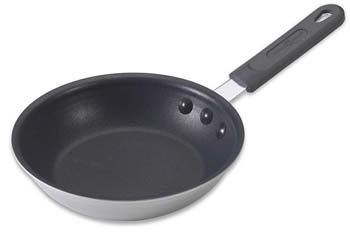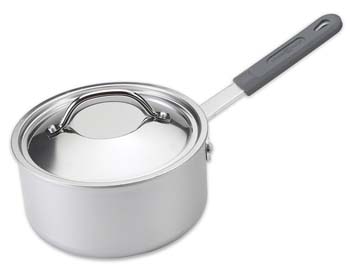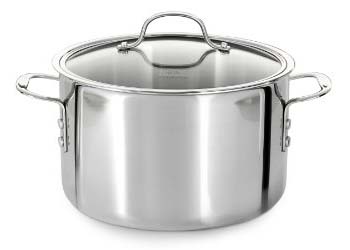POTS & PANS
Ask any serious cook, and after you listen to their opinions on knives, you'll likely hear even more on pots and pans! There are serious cast iron skillet fans out there, and even more serious All-Clad fans who'd rather go hungry than cook in anything less!
So, what you're about to read on this page is my take on the subject. First off, you only need 4 pans to get started, and I find a whistling tea kettle to be really handy; more on that later. Here's my list:
Essential Cookware:
Non-stick Skillet, 8”
Saute Pan w/cover, 3~5 qt (10~12")
Non-stick Sauce Pan w/cover, 3 qt
Stock Pot w/cover, 6~8 qt
Tea Kettle w/Whistle
So, let's cover them one at a time. First off, you should have a non-stick skillet for cooking eggs and small saute tasks. 8" is the perfect size for an omelet or a couple of fried eggs and that's what I recommend. Because the non-stick surface won't last forever, it doesn't make sense to buy a really expensive one. I personally like professional type pans with solid rivets and a removable silicone sleeve on the handle. That lets me use the pan in the oven (minus the sleeve) up to 350˚F. You can find these at a professional restaurant supply manufactured by Nordicware, Lincoln-Wearever, Carlisle and Tramontina OR get a "Blue-Stripe" pan at Ocean State Job Lot for under $10.

Next up, you need a saute pan. This is a fry pan with straight or curved sides. Curves are nice and make it easier to flip food, but they take up space you can't cook on, so a straight sided saute pan of the same diameter will have a larger usable cooking surface. The saute pan should NOT be non-stick! Some cooking tasks require food to bond to the cooking surface for a browning reaction to take place. This creates a "fond" which can be used as the base of a sauce. Because you may want to use acids (citrus or wine) to deglaze the pan, it should also be non-reactive. This eliminates raw aluminum and cast iron from consideration. I like stainless-lined aluminum or tri-ply. All-Clad and Calphalon immediately comes to mind as a good choices and you can look for one at TJX stores: Marshalls, TJ Maxx, and HomeGoods. Expect to spend around $100 but this pan should last a lifetime.

You need a sauce pan to cook vegetables and sauces. I like something around 3 quarts. You can cook 2 quarts of food in a 3 quart pan, but you can't cook 3 quarts of food in a 2 quart pan. If you're starting with just one pan, make it a 3qt. This should be thick aluminum and a non-stick surface is useful since it helps prevent you from burning rice and other starches. Look for something from Nordicware or T-Fal. If you opt for a non-stick pan, don't spend a lot since you will probably replace this pan in 5 years when the non-stick coating wears out. Again, TJX stores and OSJL are good places to find one for $10~$15.

You need a stock pot or Dutch oven to make stew, soup, or simply cook a box of linguini. For 2 people, 6 qt is fine; for family-size cooking, go with 8 qt. This, like the saute pan, can be stainless-lined aluminum or tri-ply. Again, All-Clad and Calphalon are good choices but they can be really expensive, so keep an eye out at TJX stores for a bargain or use a coupon at Bed, Bath & Beyond.

Finally, I really like having boiling water to pour over vegetables to start the cooking process instantly. I use a kettle for this. I recommend one with a whistler that can NOT be removed, left open, or disabled! That way you'll be less likely to boil it dry. Mine is a Copco similar to this.

A few comments:
I don't like cookware sets and don't think you should you start with a set. Because I recommend that half of your cookware is stainless-lined and the other half is non-stick, you won't find a set like that. Furthermore, even good brands like All-Clad include disfunctional pots and pans in their sets. For example, their 3-qt sauce pan is perfect because it is wide enough to cover a standard burner and not too tall. Yet, they include a tall and narrow 2-qt saucepan or an unwieldy 4-qt saucepan in sets. Ditto for their rediculous 7-qt stock pot... to tall and narrow for making stew or simmering stock!
If you cook on gas, your pans should have sides just as thick as the bottoms because gas heat wraps around the pan. If the sides are thin, particularly with a sauce pan, food will burn. Electric stoves only heat the bottom of the pan, so thick-bottom pans with thin sides are OK.
You may not use the lid all the time, but you should have a lid for every pot and pan! A lid allows you to cook more types of food. It retains heat and allows food to cook faster as well. The lid can also be a very effective fire extinquisher; never fry without it handy! I hate glass lids. They can break and they're hard to clean. All my lids are stainless steel with a hot but oven-proof loop. If you buy professional pots and pans, they do not typically come with lids and must be ordered separately.